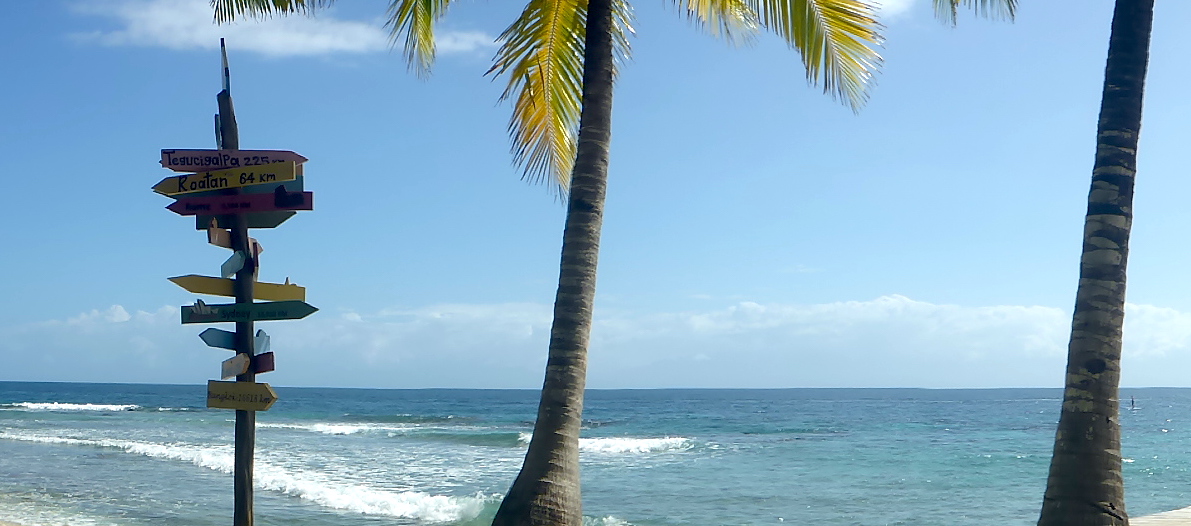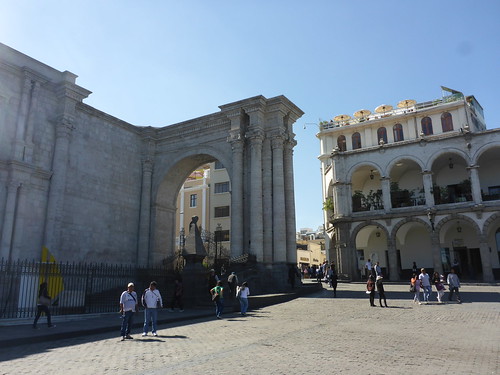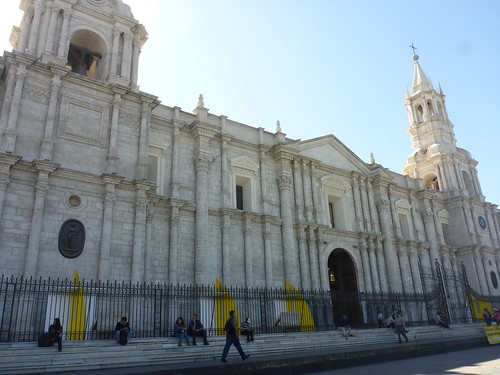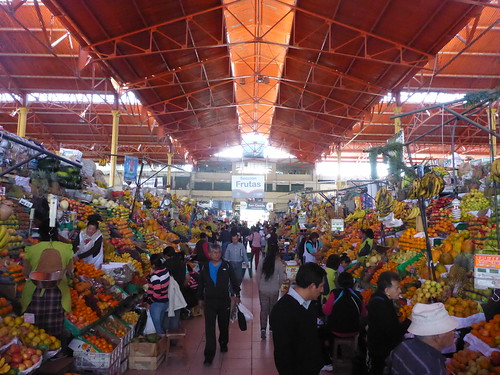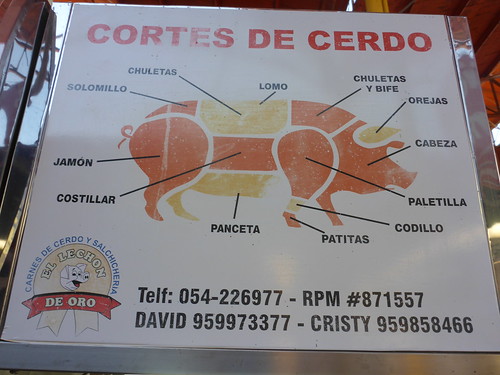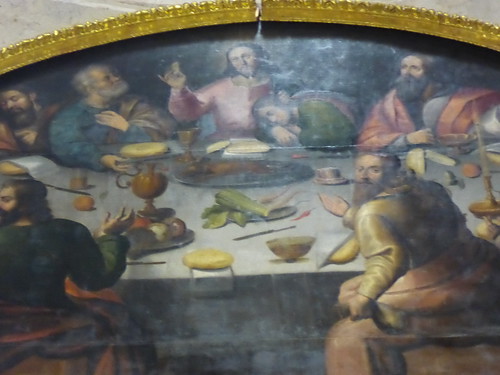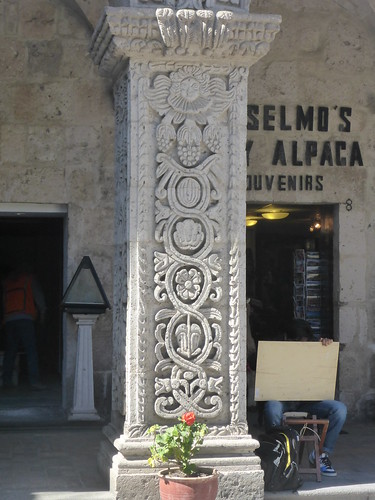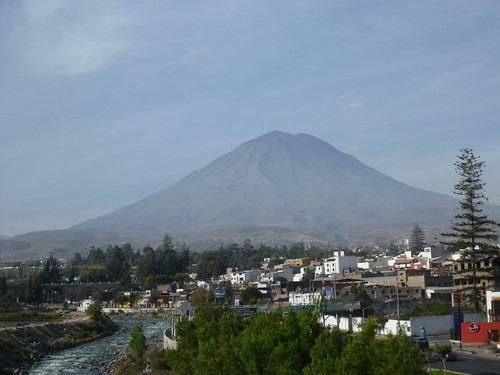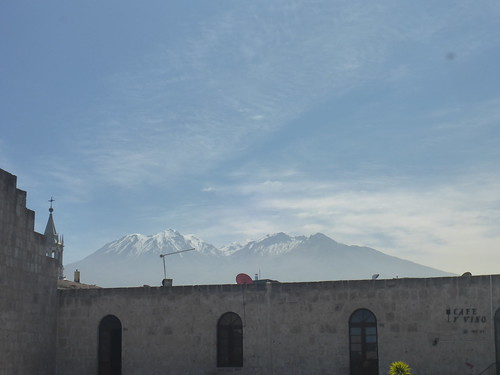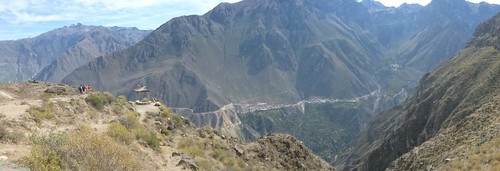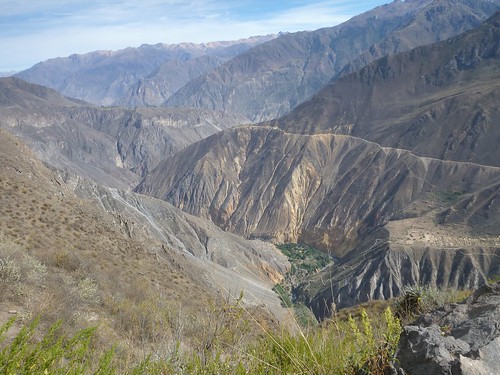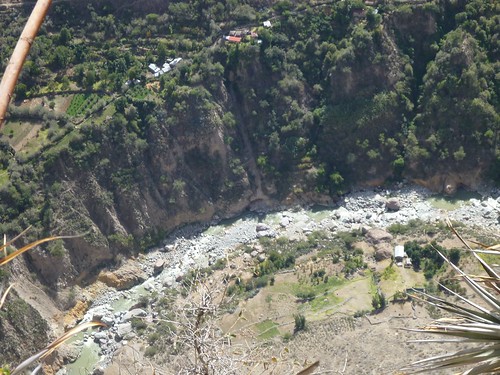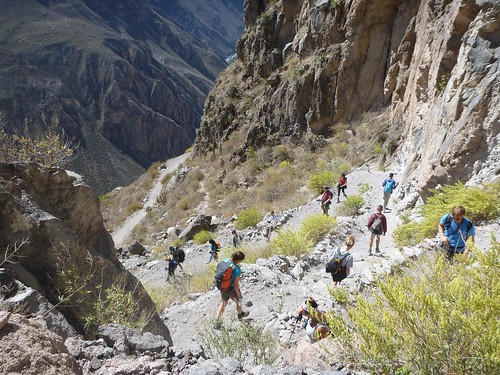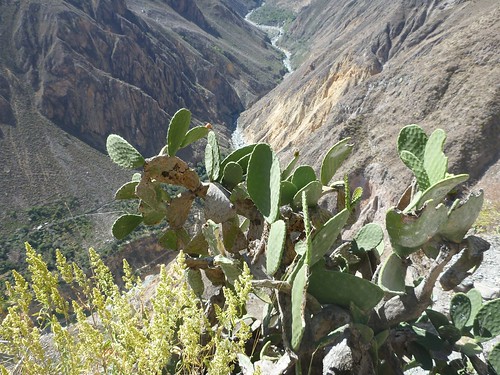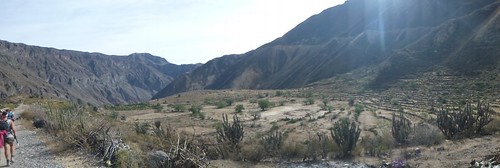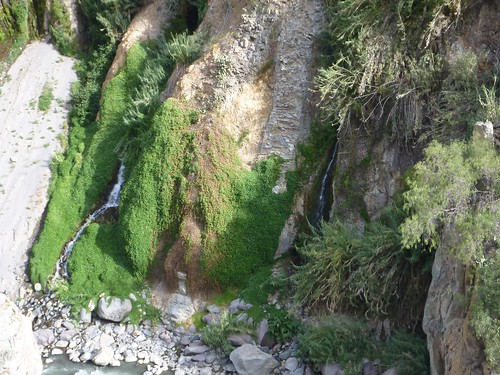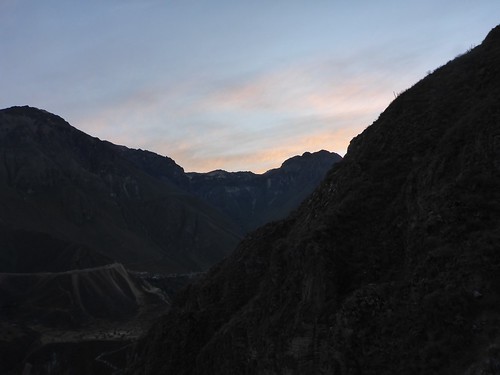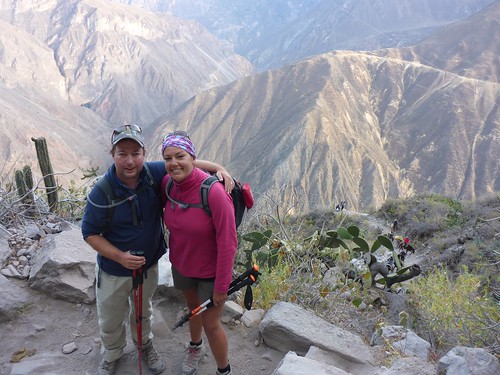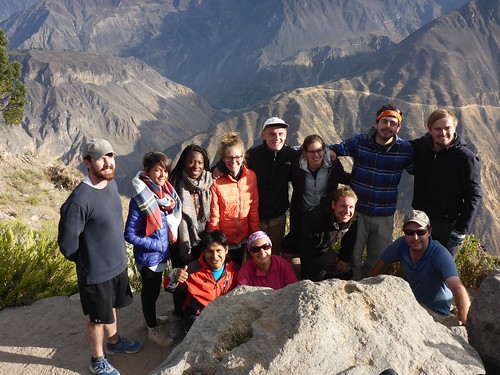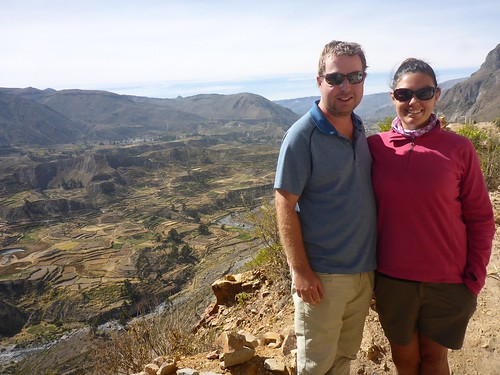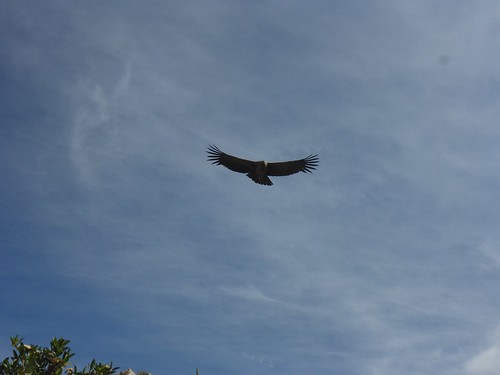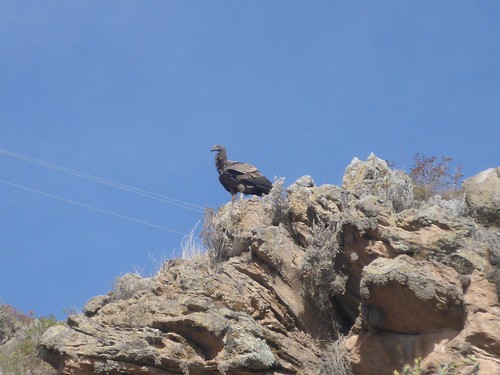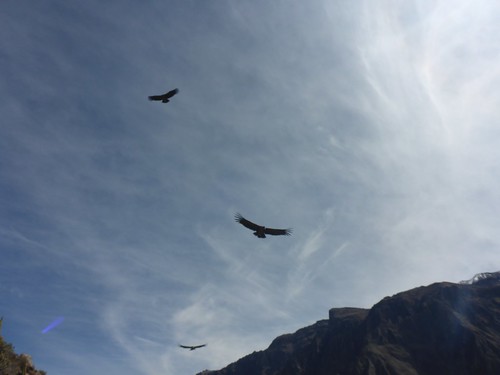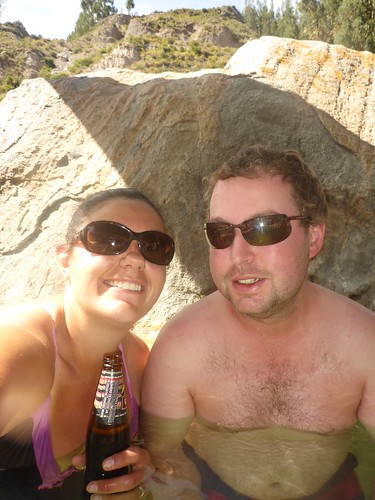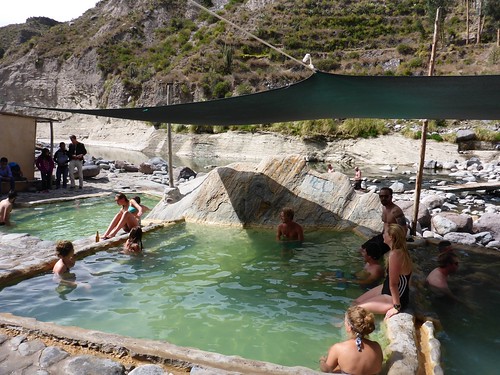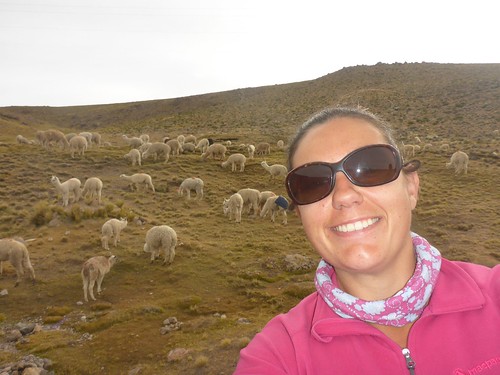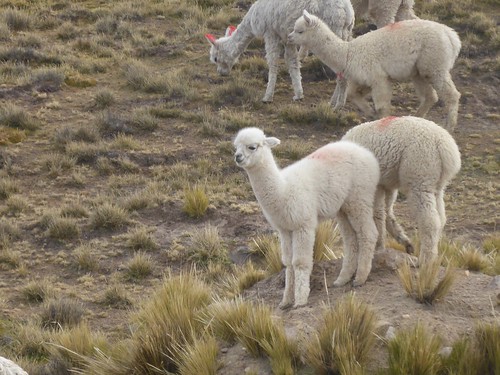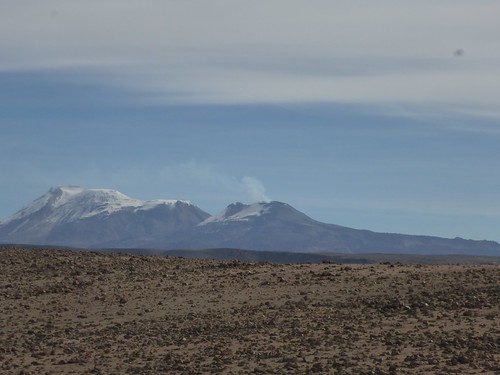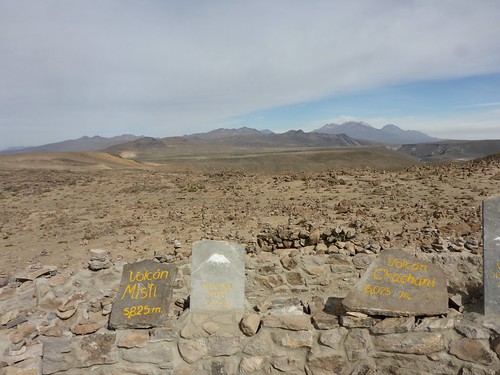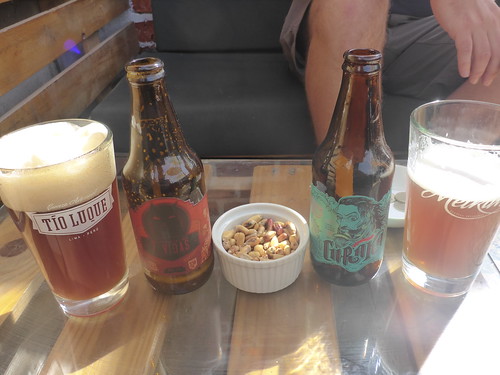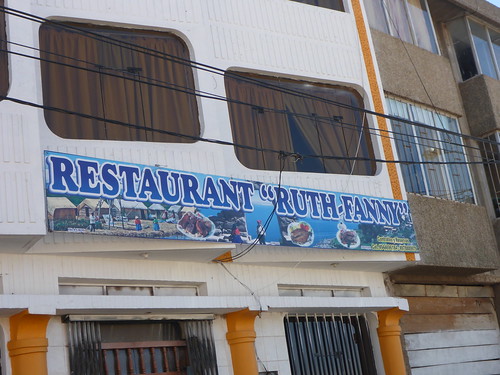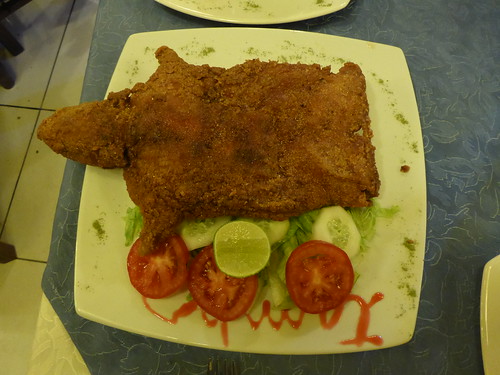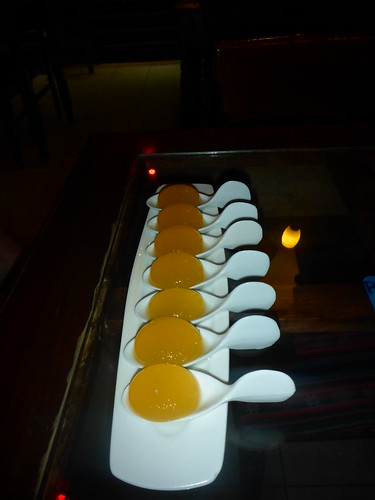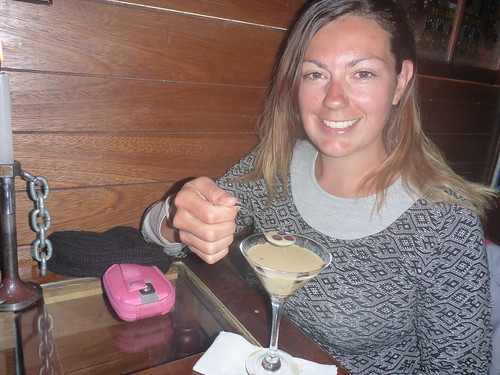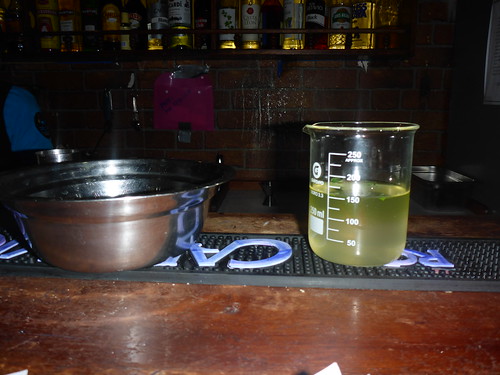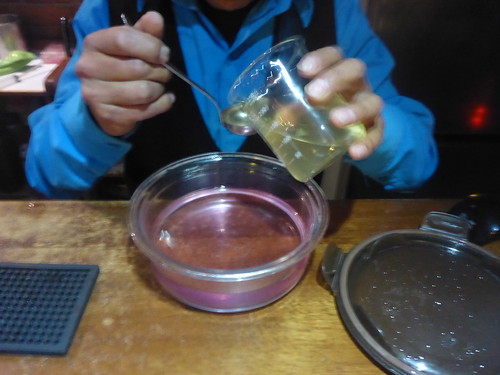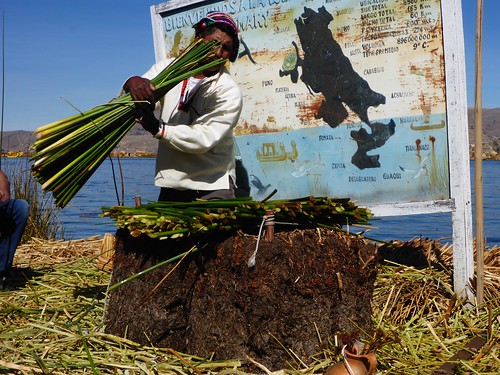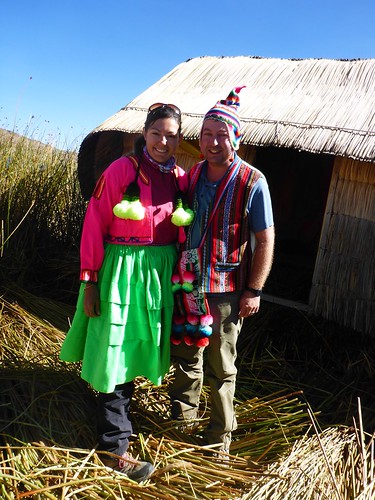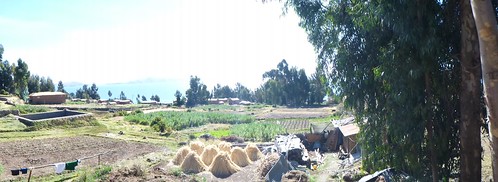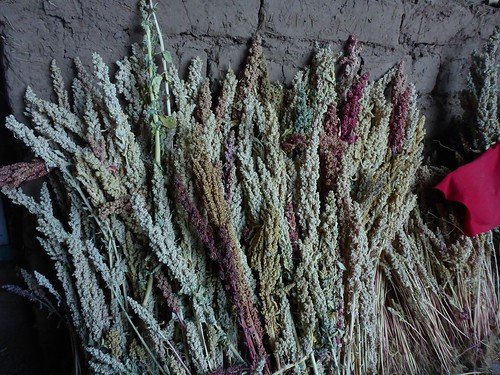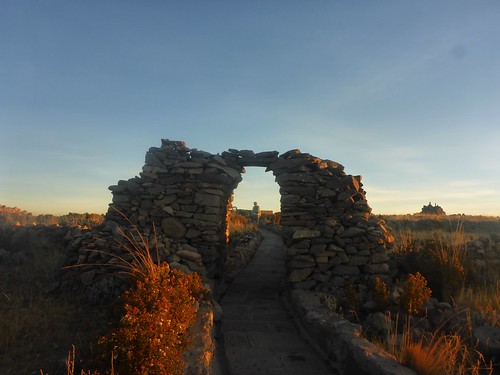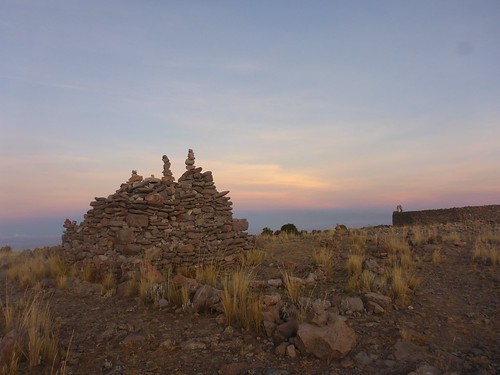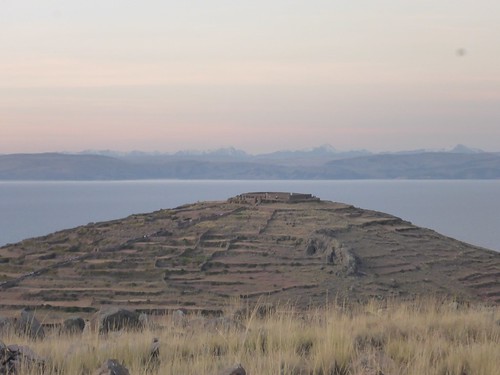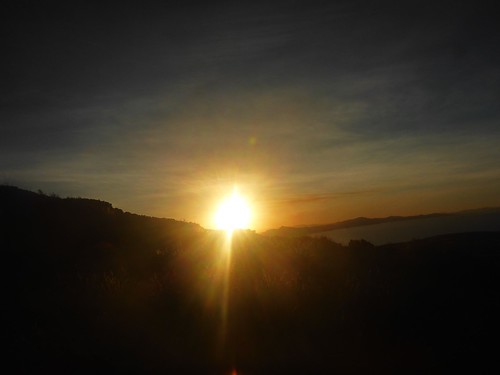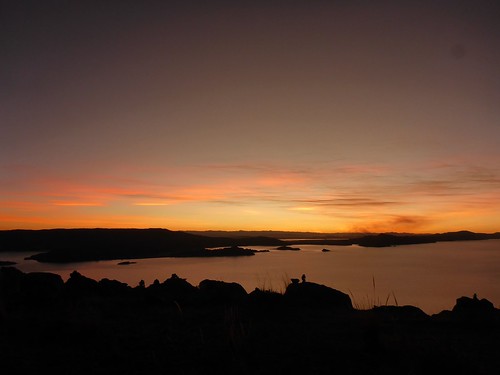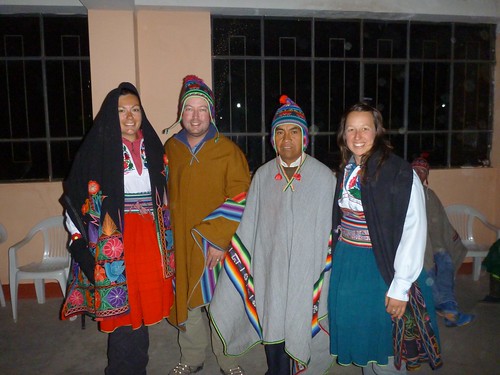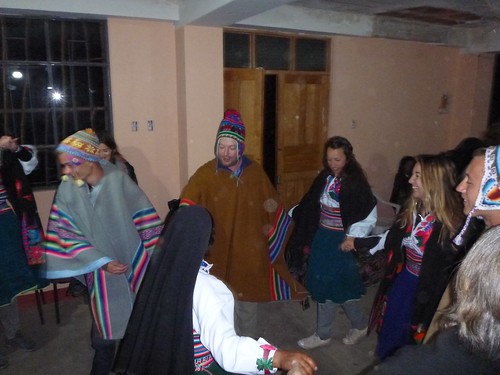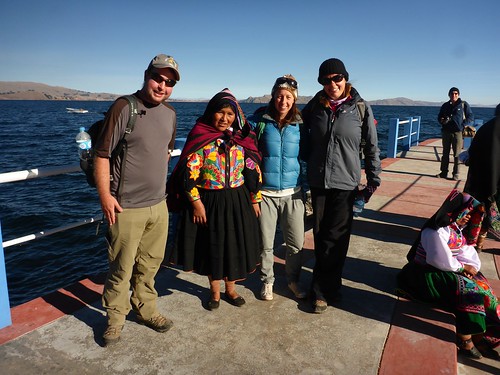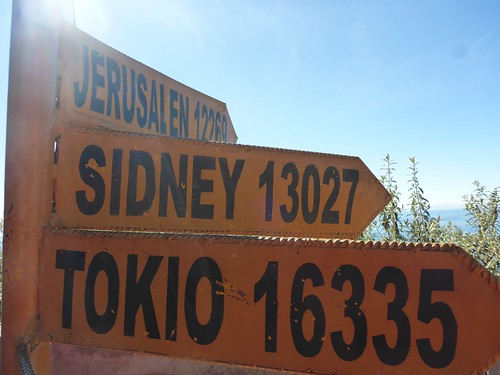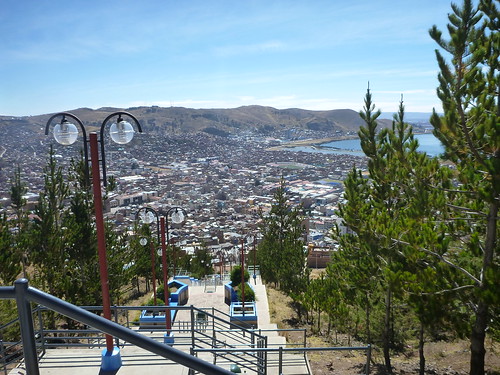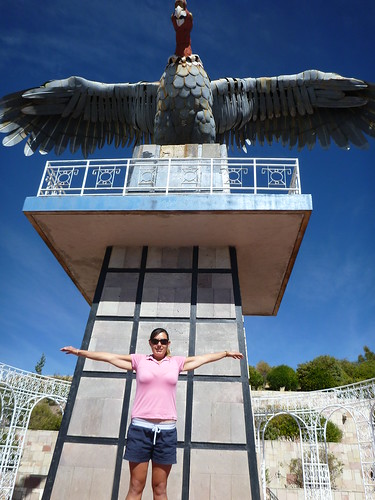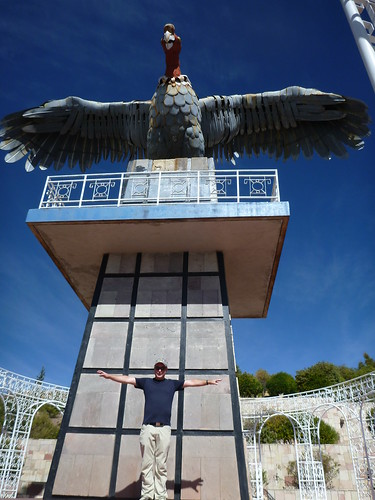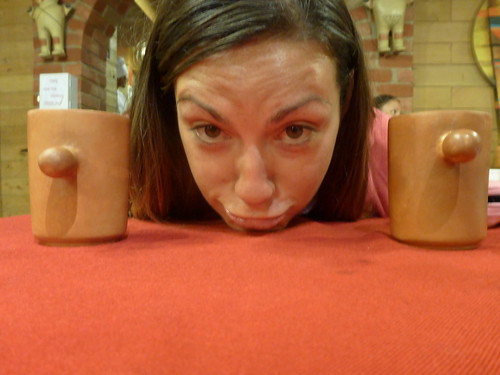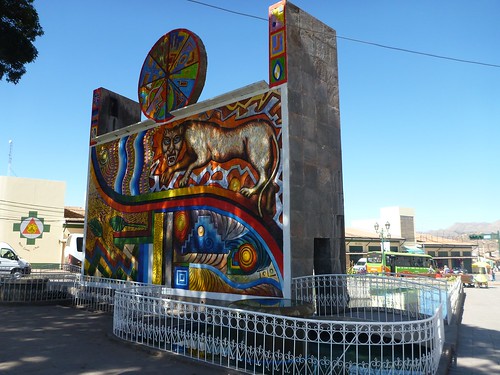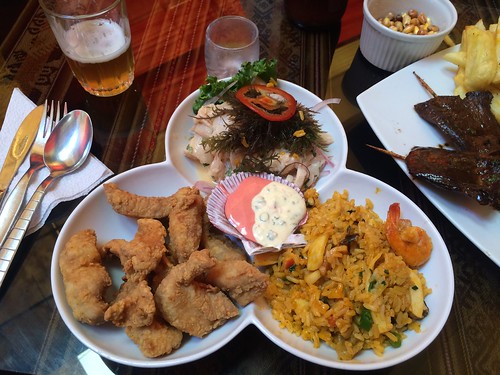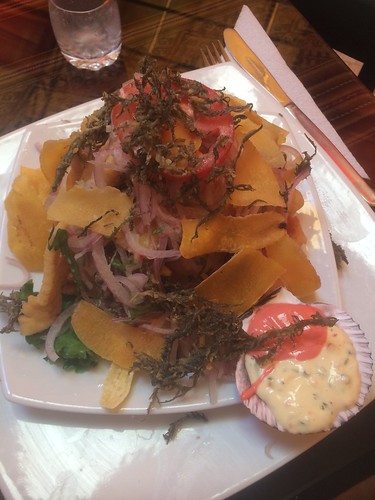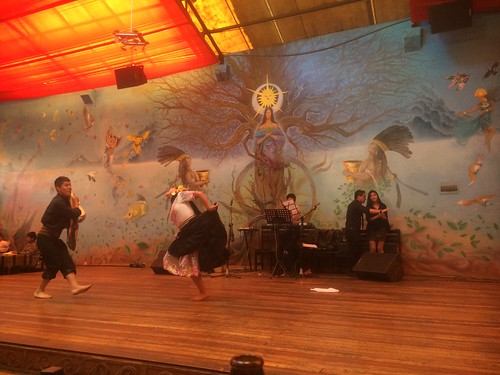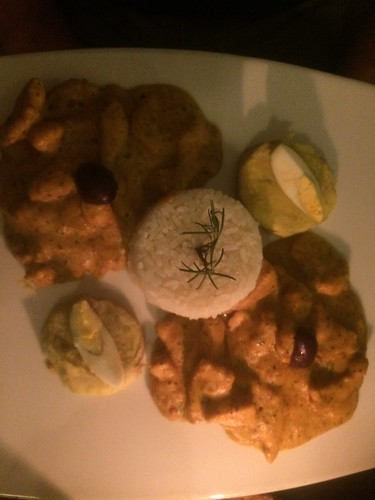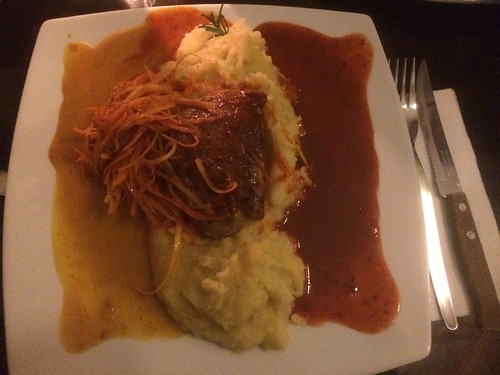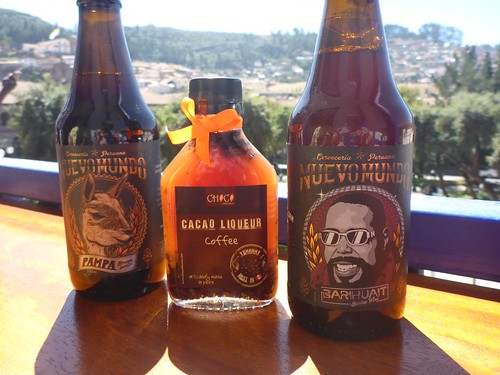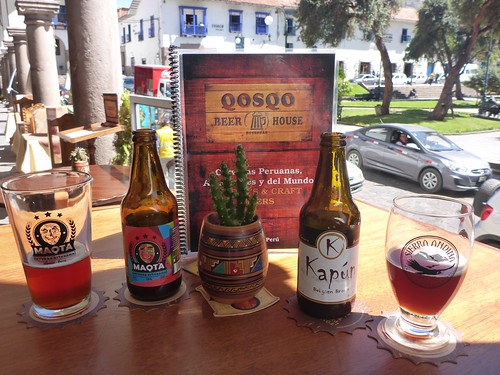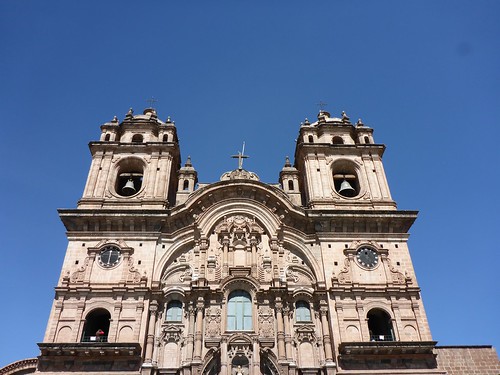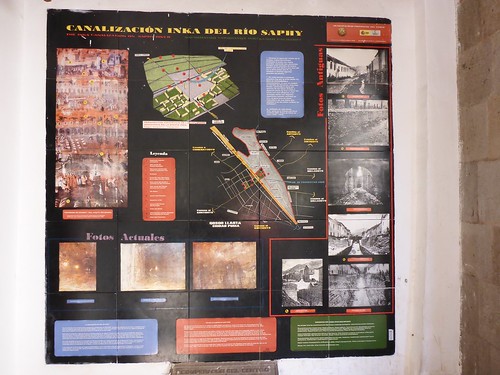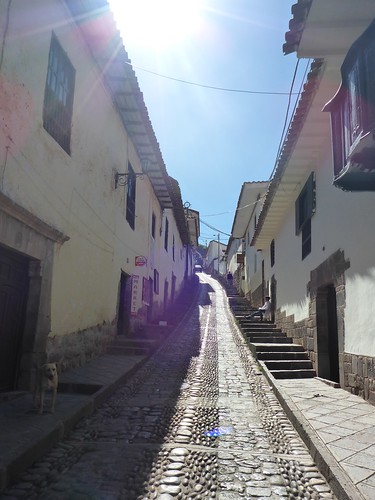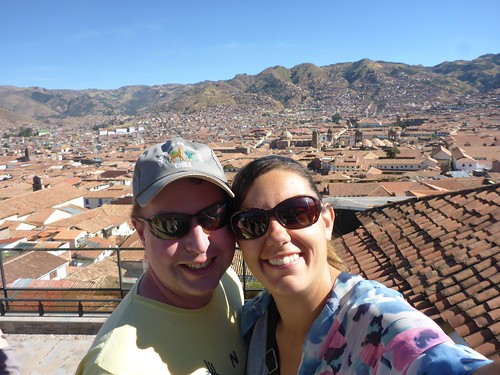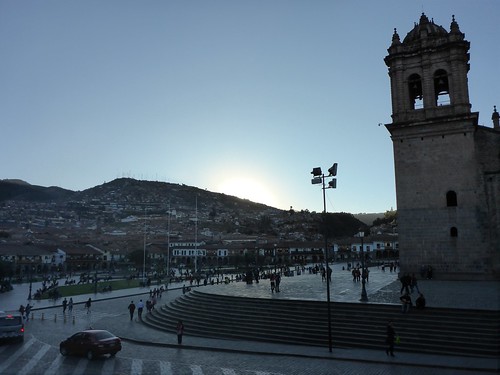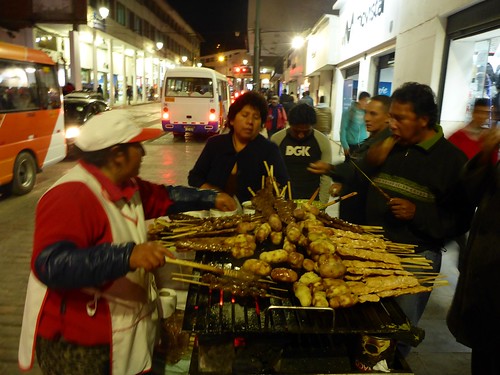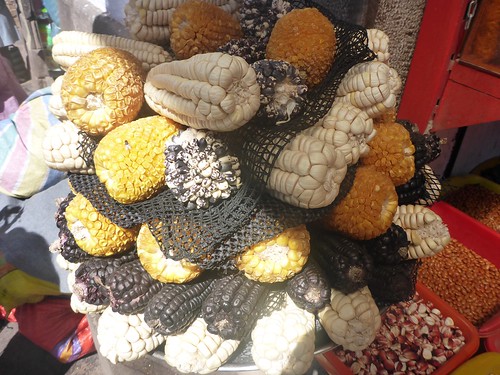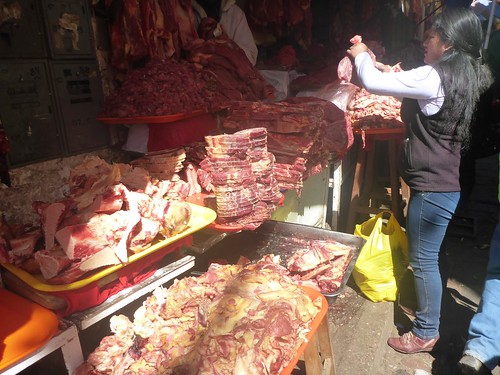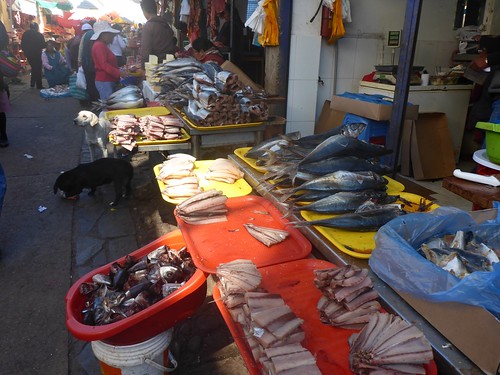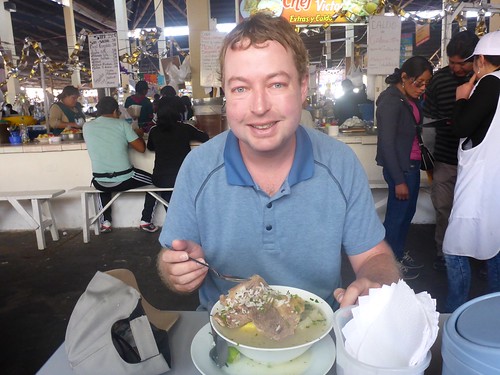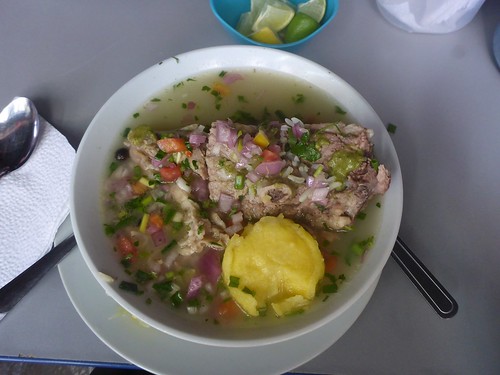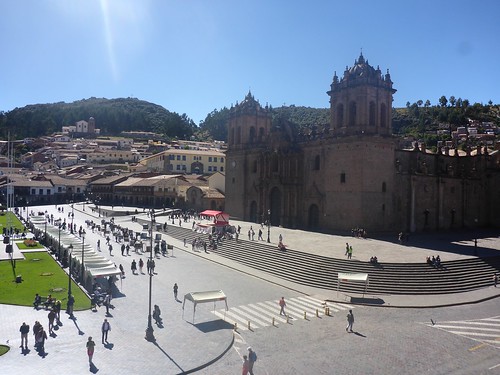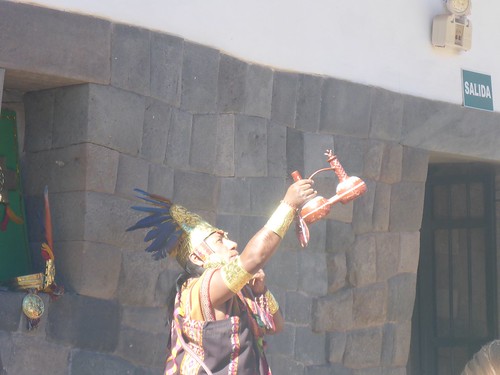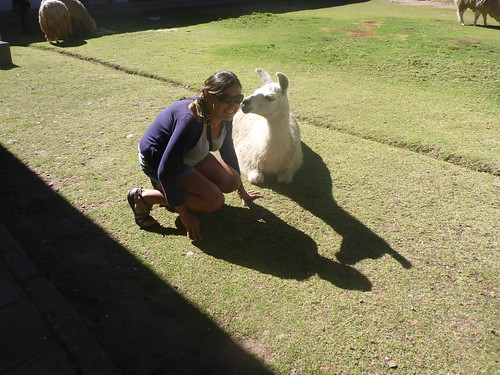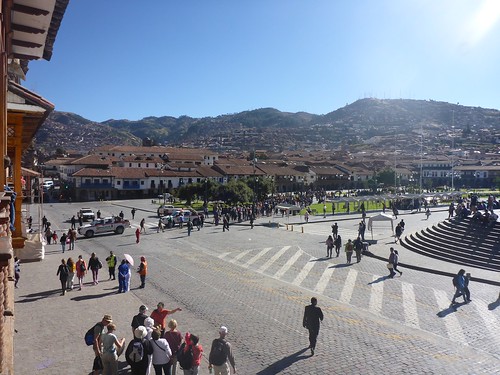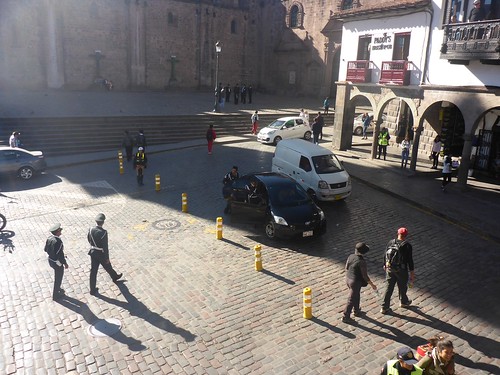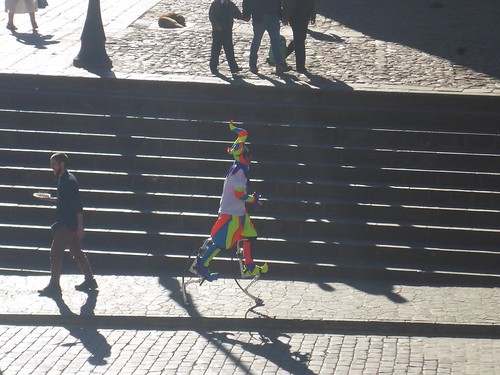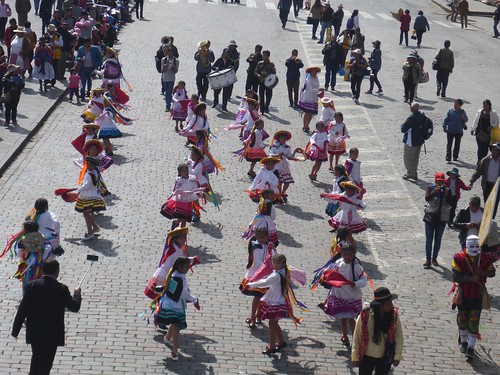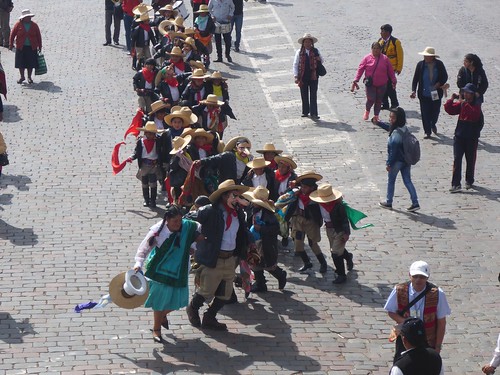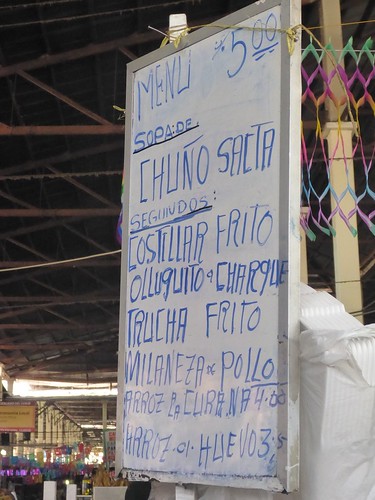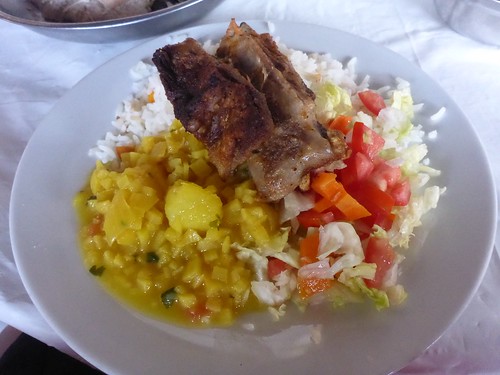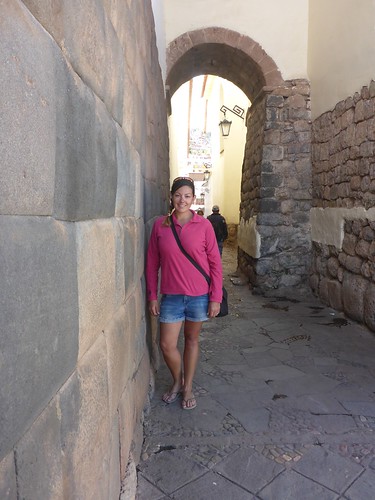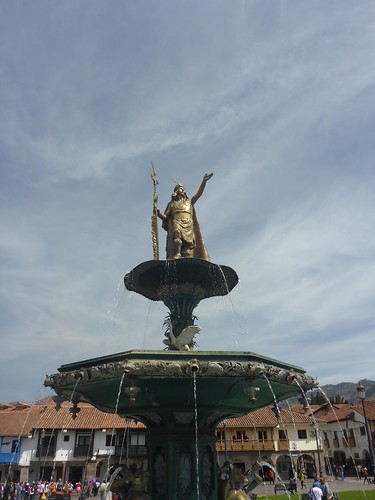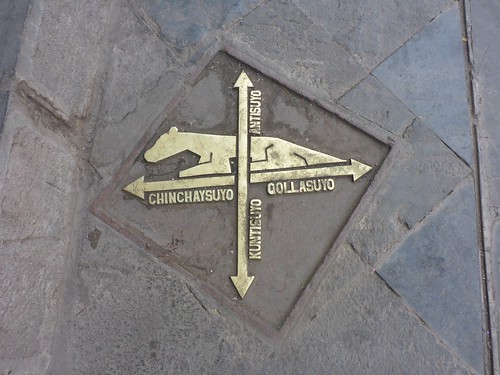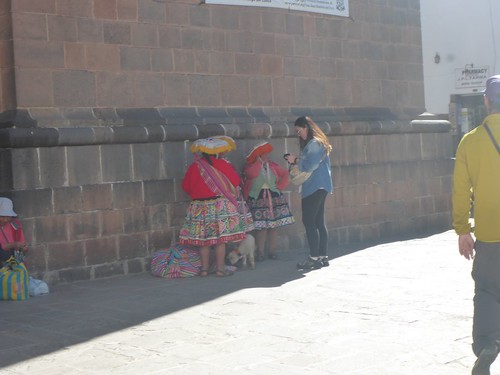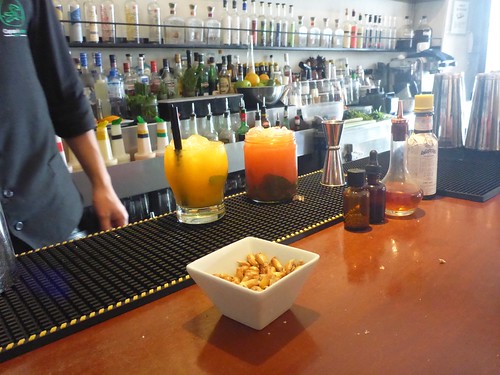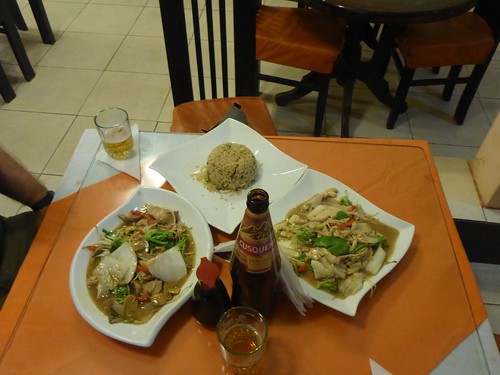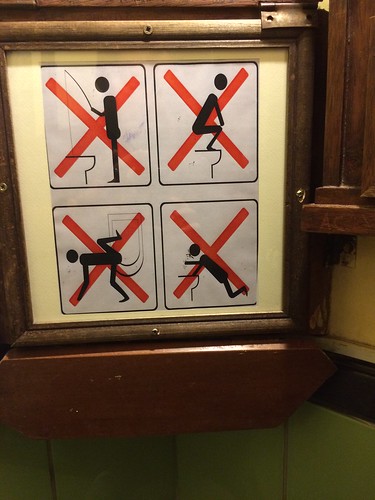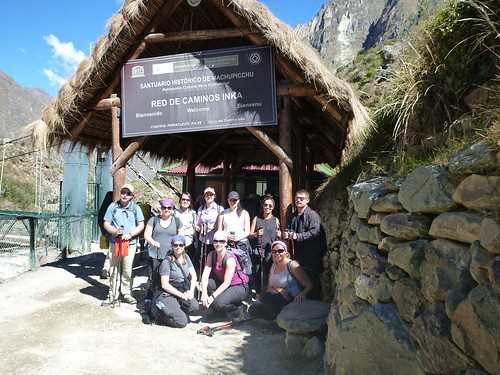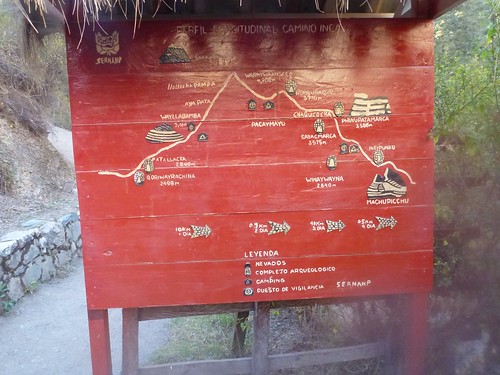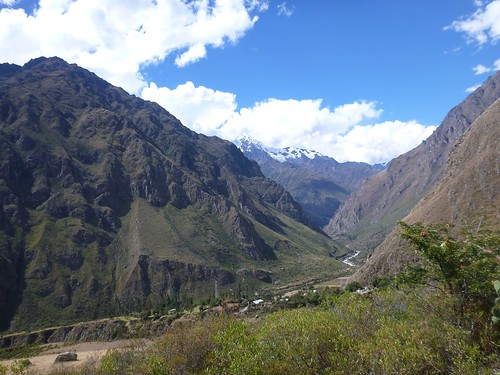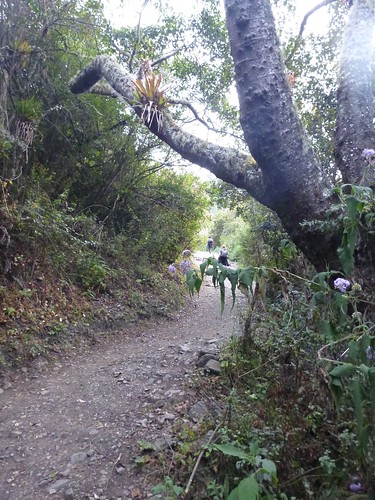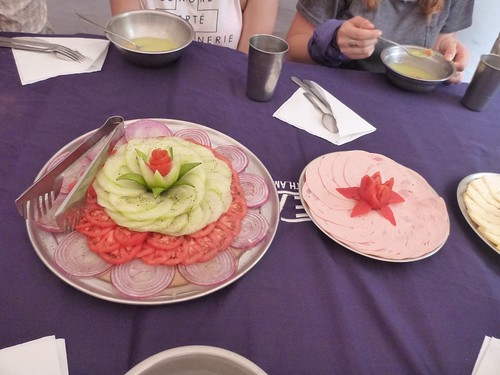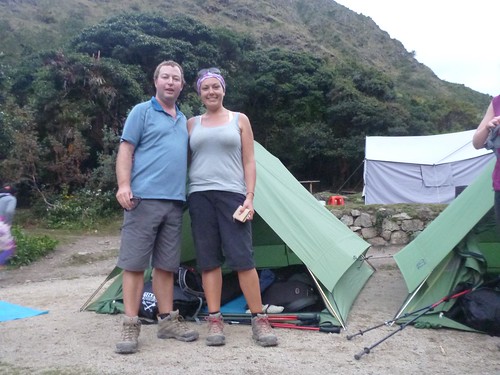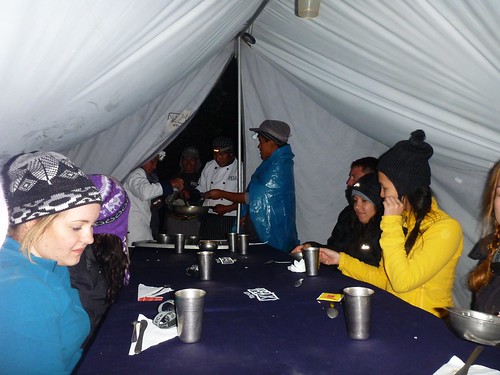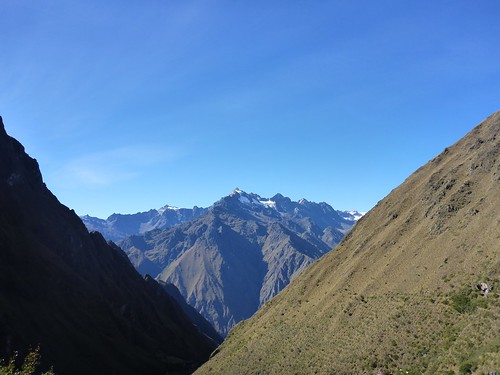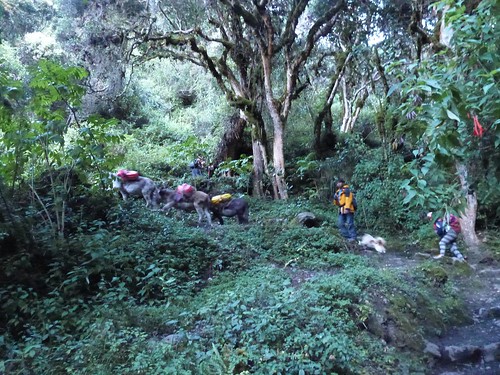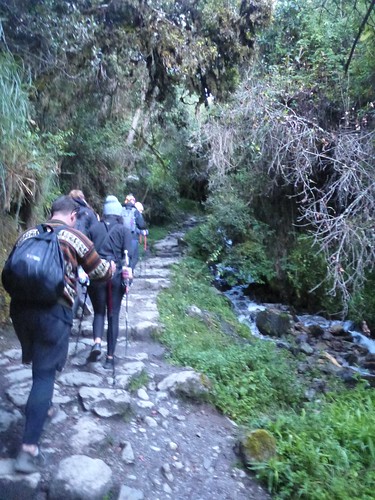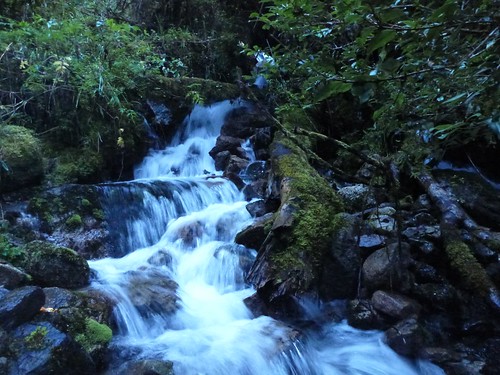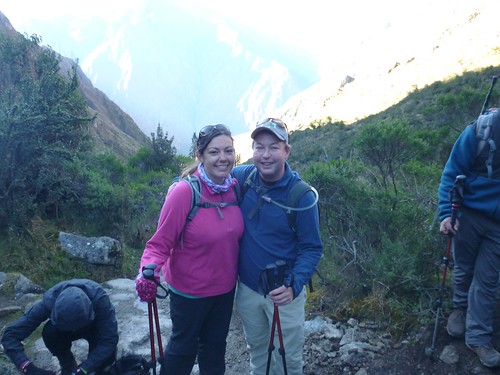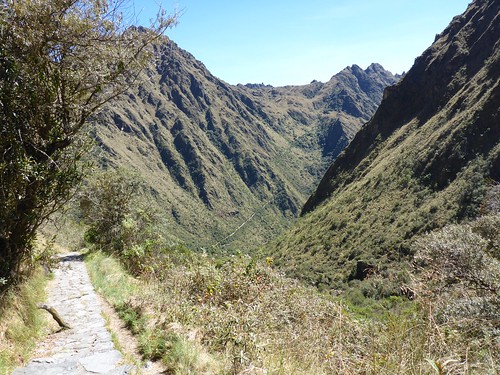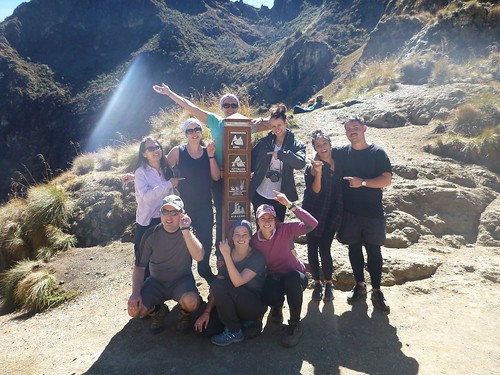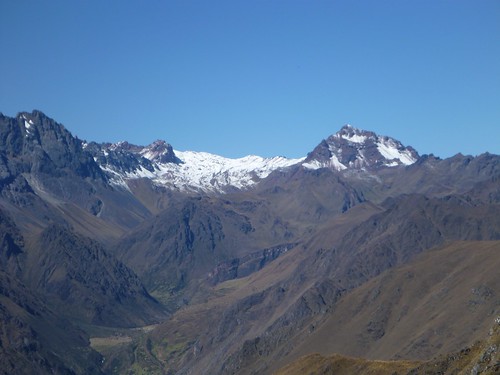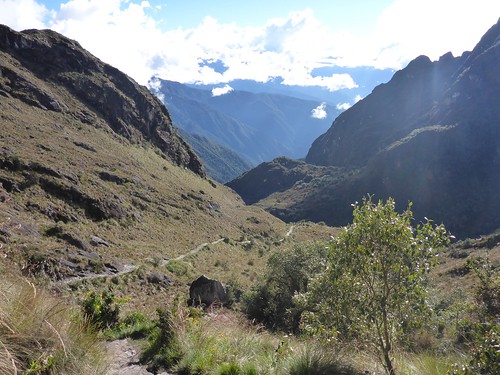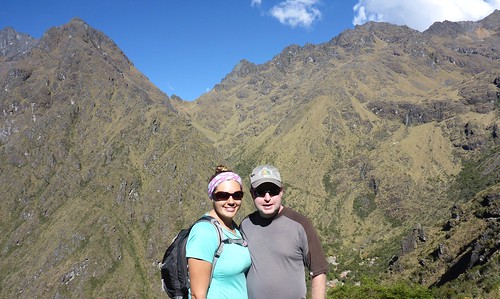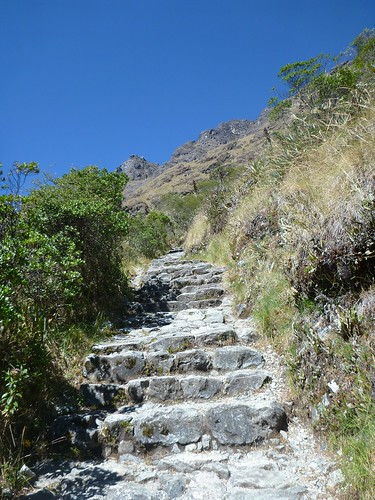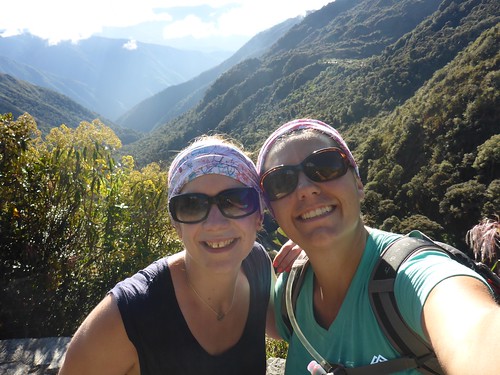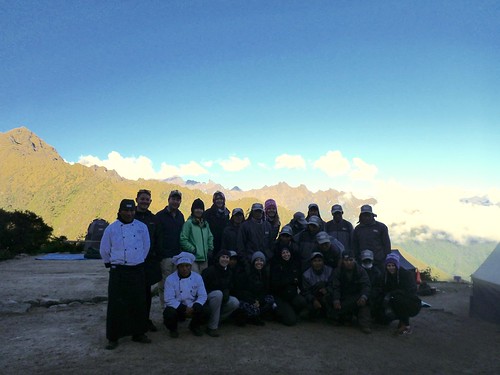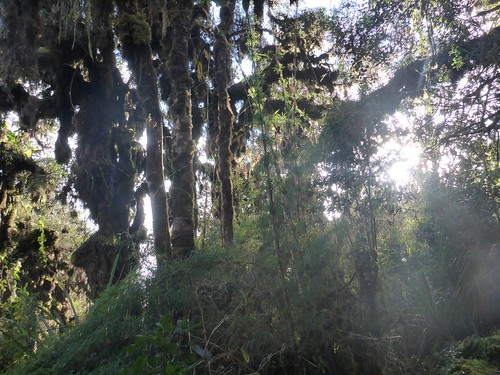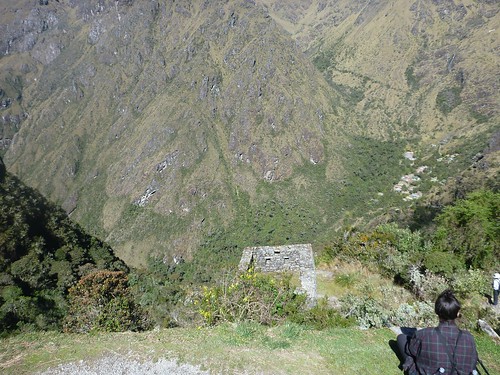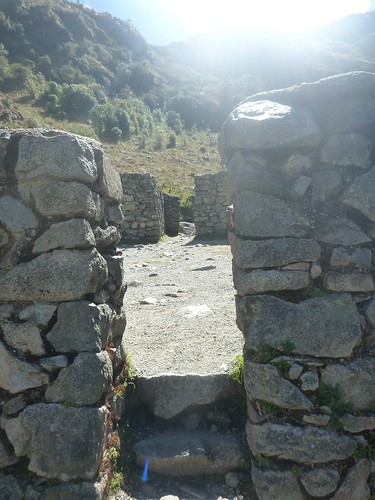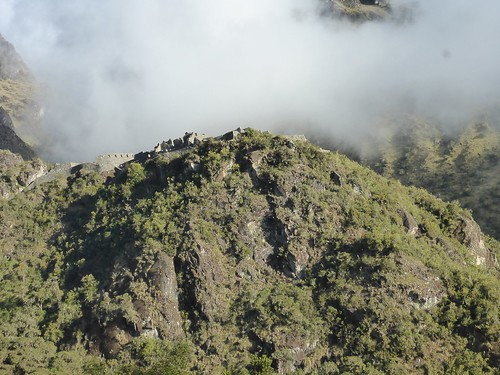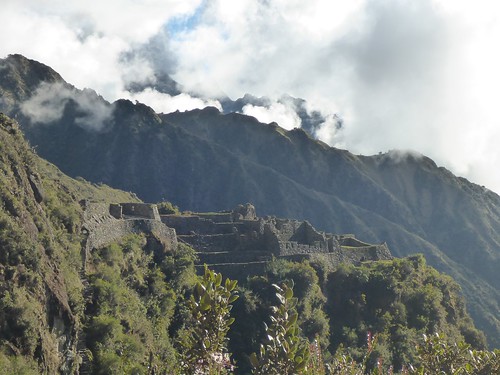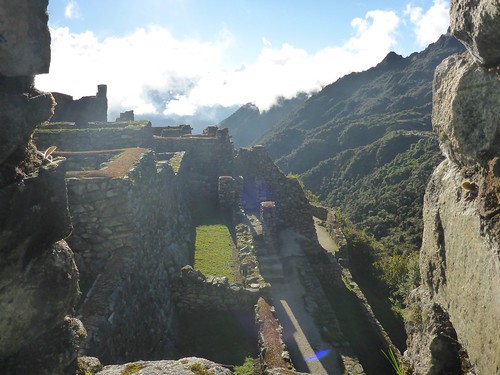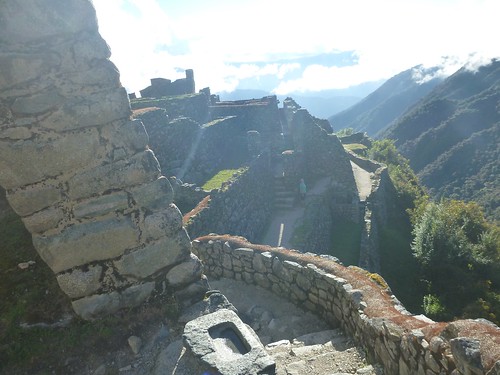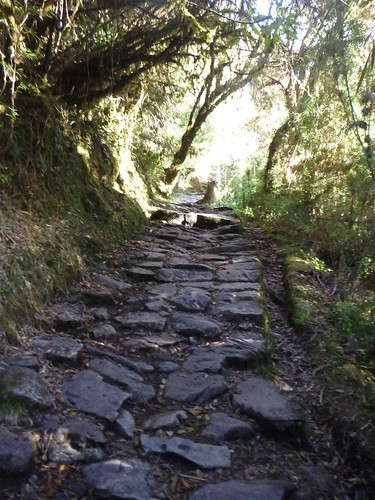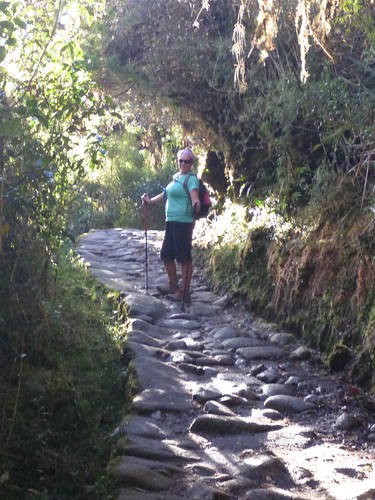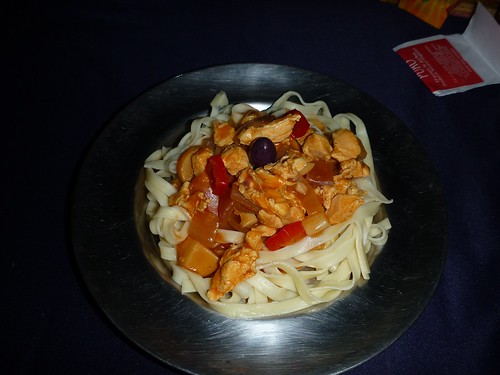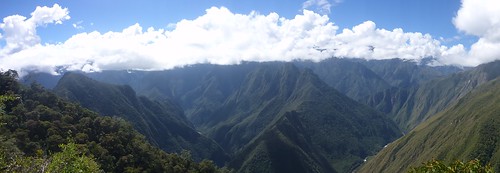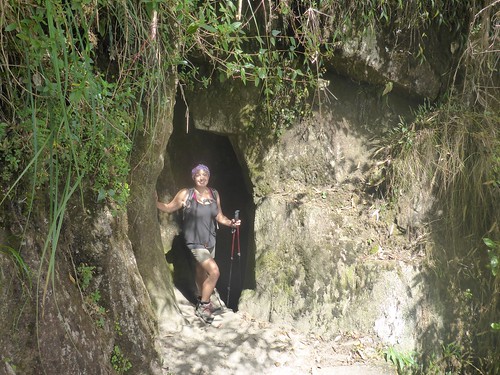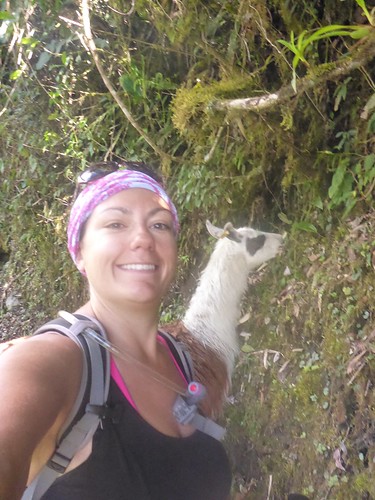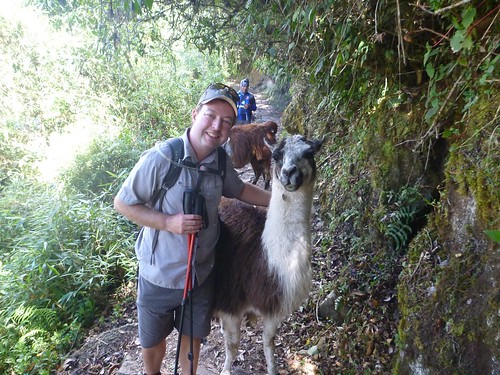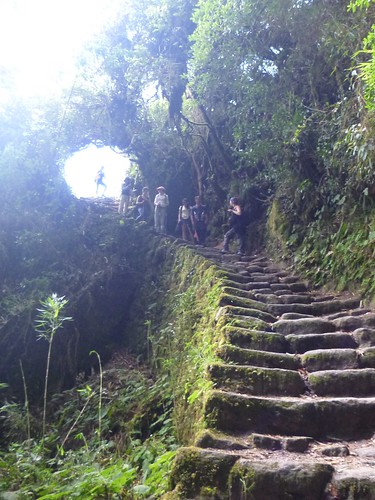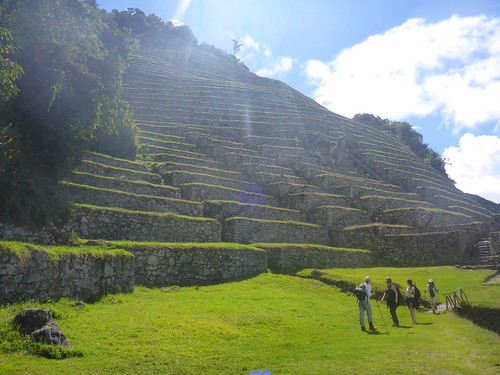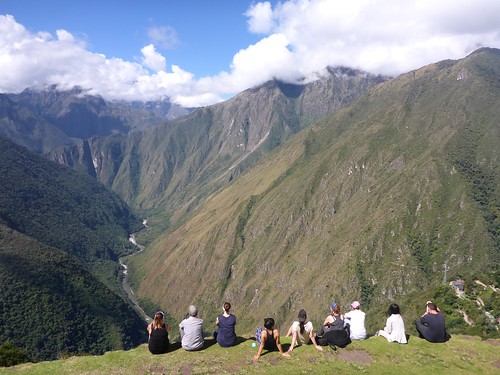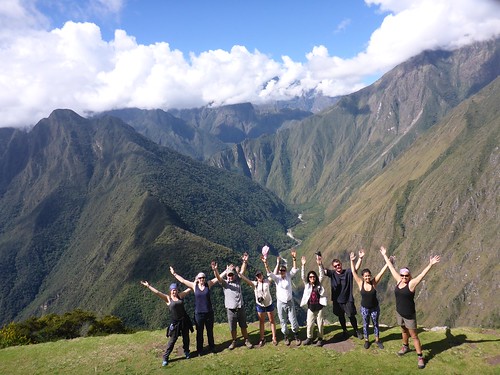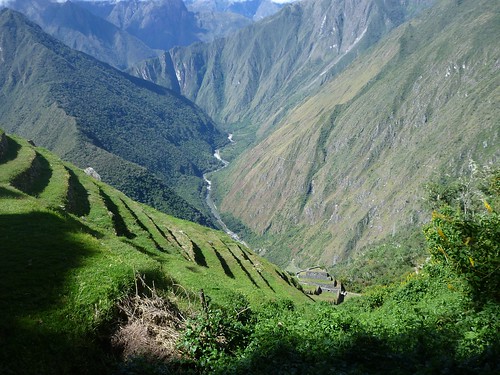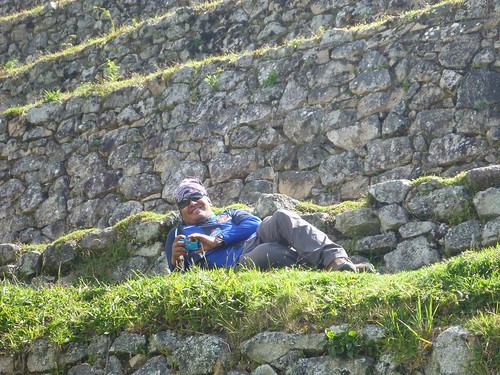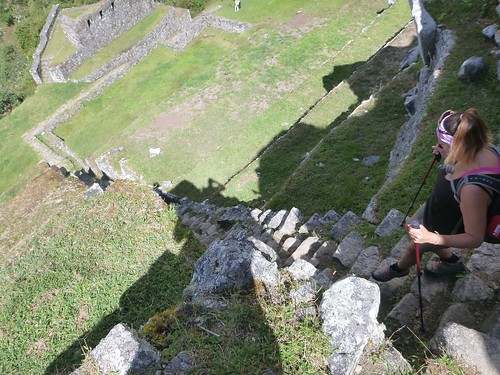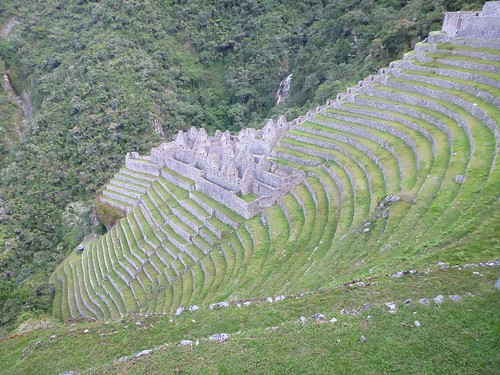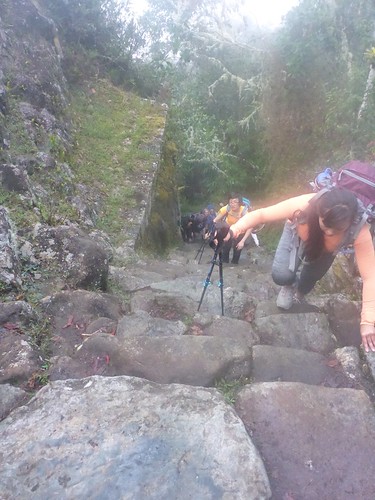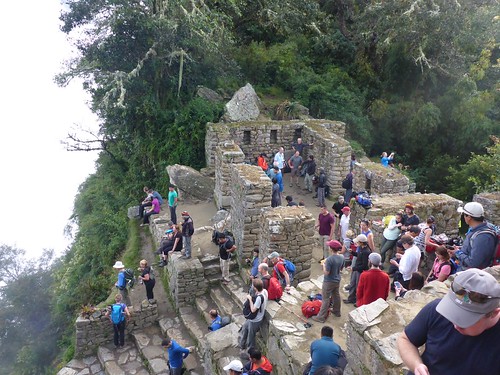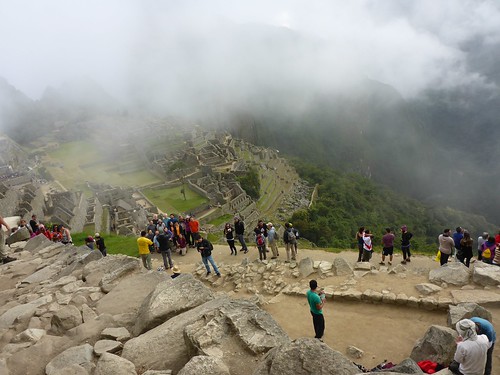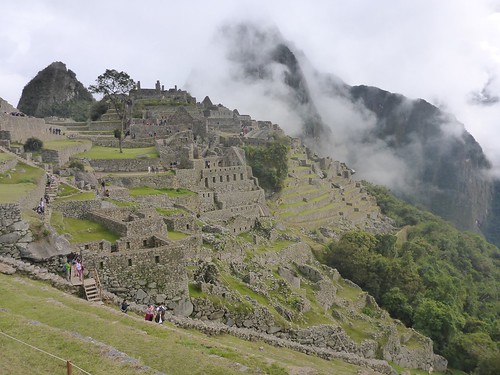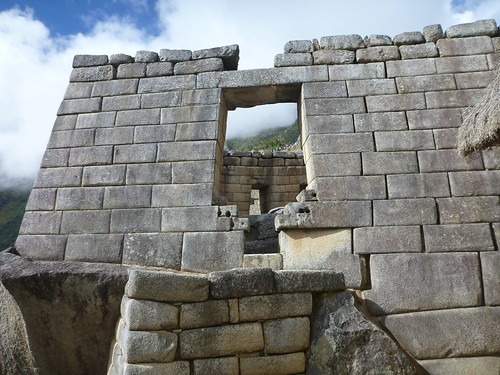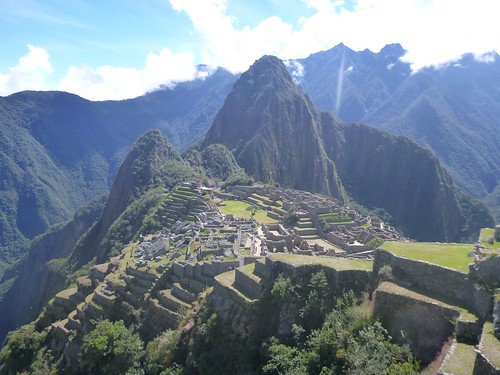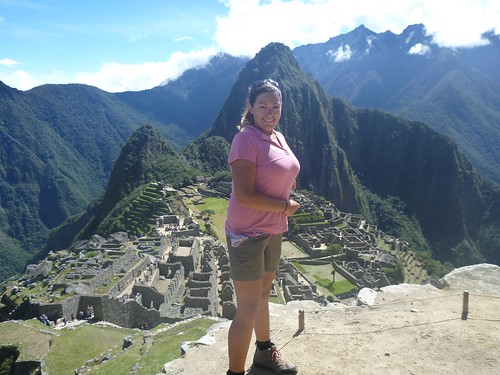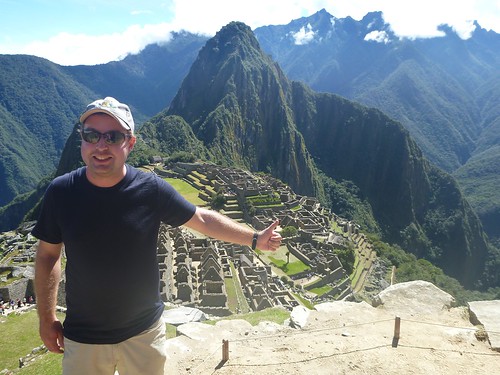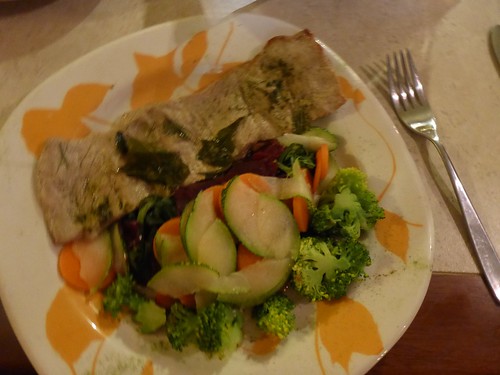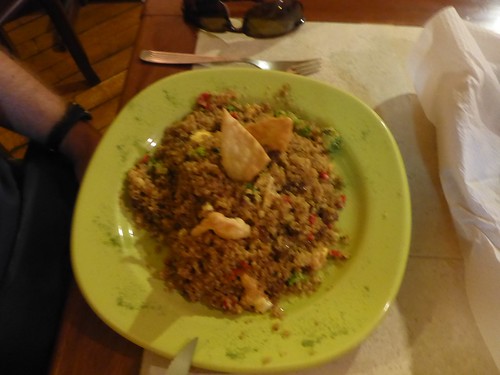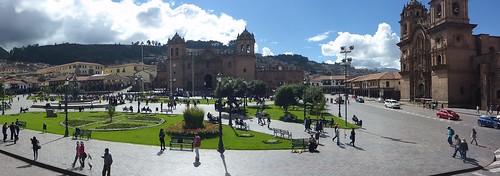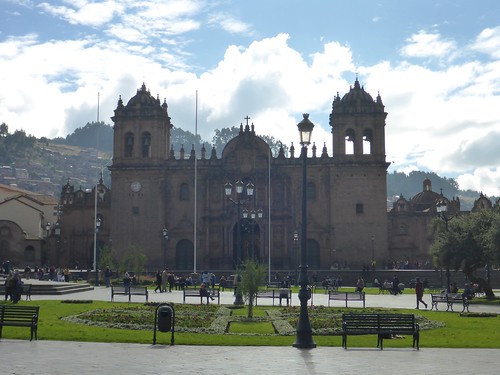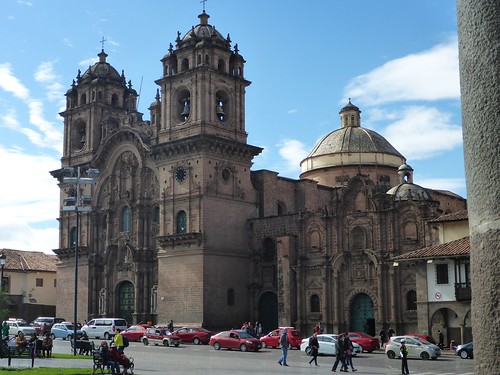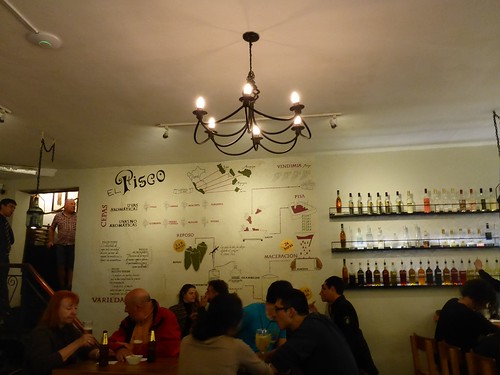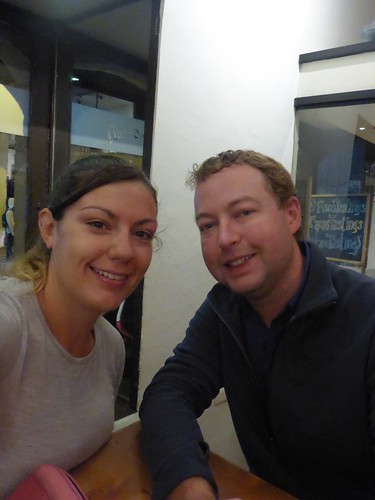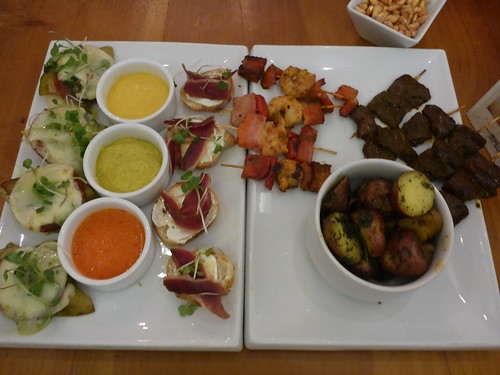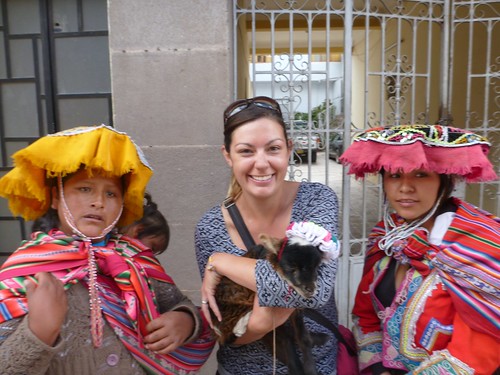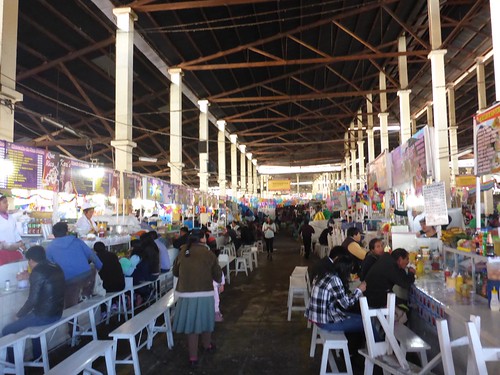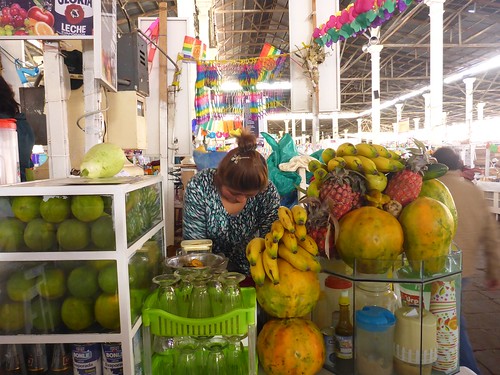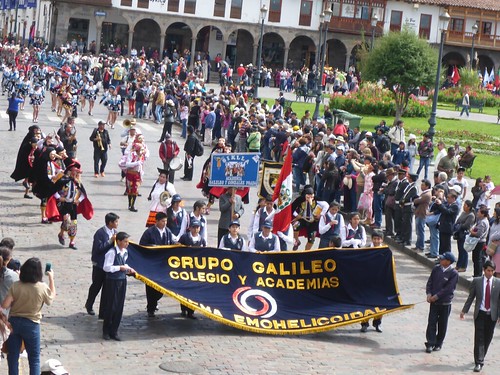Air! Wonderful Air! Walking around Arequipa is much easier than walking around the cities that we have been in for a while. Perhaps cities like Cusco could look into this air thing and import some more.
We arrived into Arequipa on the PeruHop bus at 5:30am, however we (and several others) couldn’t check into our hostel until 2pm or so. The person at reception seemed less than impressed at being woken up so early and wasn’t overly forthcoming with information. She did say that we could wait in the common room for a while until the breakfast places opened which would have been nice, except that there was someone sleeping on the couch in the common room. We didn’t want to turn on the lights and wake them up :( Since there wasn’t much else to do, we decided to catch up on some admin tasks, also a mission seeing as none of the power points seemed to like any kind of power plug/adaptor put into them - they either didn’t work or the adaptor fell out of the wall.
Once it was a more reasonable hour, we walked the few blocks to the Plaza de Armas to look for some breakfast. As usual we were harassed by every man and his dog to visit their restaurant; being thrown menus and shouted at along the way. Eventually we chose a restaurant, almost purely based on the fact it was on the second storey of the building, with their balcony overlooking the plaza. Luckily the food turned out to be nice enough, although the coffee was below average… thankfully it wasn’t premade with the half tonne of sugar that seems to be a popular addition in South America.
With some caffeine to help us, we decide to explore the city, before the lack of sleep caught up to us. As we were leaving the plaza, we saw something that would turn out to be common in Perú, musical garbage trucks! As a kid you might have heard a certain song in the distance to announce that an ice-cream truck was near, and to harass your parents. Instead of children having icecream, the musical trucks here are to remind you to put your garbage out to be collected.
We spent a few hours wandering around the town, the block surrounding the Plaza de Armas was closed to traffic, housing artisanal shops, tour agencies and restaurants… we stumbled across another pisco museum but decided that we might have a little break from the pisco sours for a little while; albeit delicious they give really bad hangovers. Whilst exploring we thought we might hit up the local markets to find some mystery fruits to try. Unlike home, the fruits in South America are full of flavour and really fresh, and in most cases, have been grown by the vendor at the market. You can generally buy a week’s worth of fruit and vegetables for less than $5aud.
Today we didn’t get too adventurous with the fruits, settling on a giant papaya and buying some meat and cheeses to have for dinner. We were happy to see that one of the signs in the market had a picture of a pig and what the different cuts were called in Spanish, thus making it much easier to be able to decipher what kind of mystery meat we were getting in restaurants whilst ordering off the menu. Our pisco hiatus didn’t last too long, especially not when we had a look in the grocery store and were able to buy a bottle for a few dollars. This resulted in us having fruit cocktails, with a few olives, cheese and biscuits for dinner. The hostel we were staying in had a ping-pong table, as well as a pool table, so of course, we ended up attempting drunken pool and ping-pong… thankfully there were no injuries.
The Hangover Begins… with a walking tour
Who knows what time we decided to go to bed, but it wasn’t early enough as Tuesday morning was a little bit of a rough start. We’d decided that we were going to the walking tour of Arequipa; the walking tours have been really helpful in getting a crash course of each city’s history. We needed to meet inside a chocolate/beer/coffee shop just off the Plaza de Armas, as with everything in South America the tour guide was running late, and we weren’t sure if we were in the right place, it was twenty minutes before the guides turned up.
After a brief introduction from the guides, the group split into a larger English group and a smaller Spanish group. We were ready to go, except for one of the American backpackers who had decided that rather than buying water in the 20 minutes she had been standing around, she’d do it just as we were about to leave. We eventually headed off, and walked a hundred meters to the Monasterio de Santa Catalina, which takes up an entire city block (around 140m square). The monastery belongs to the Dominican order, and was built in the late 16th century and made larger in the 17th. There are a small number of nuns still living in the convent, but most of the site is over to the public now. It is quite expensive to visit for tourists: S./25 ($10aud) for basic entry, but S./40 ($15) for full access and a guide. Dee is a bit tired of churches and monasteries, and James visited it last time he was in Perú, so we didn’t come back later to look inside.
After a few blocks more walk, we passed the Monasterio de Santa Teresa, and continues along past a collection of churches and other buildings until we arrived at the Iglesia de Santo Domingo. That church is a Jesuit church, the outer façade has a lot of intricate work with many animals shown, reflecting the indigenous community’s input into the design and building of it. As occurs in a number of churches in Perú, the “last supper” painting has a local twist - a round table, guinea pig as the meat, with corn and potatoes served as the meal, chillies on the table, as well as glasses of Chicha (the local fermented-corn drink).
We passed the Mercado Central, which is the big local market that we had been to the day prior, but others in the group found out why they should go: mystery foods! And the markets are really cheap, the produce is better than the local supermarkets, and it really is helping out the farmers in the area surrounding Arequipa.
Not far away there was a short passage through the outer section of a building into courtyard inside. At the entrance, there was a woman selling a local Arequipeño specialty, “queso helado”. The name means “frozen cheese” but it not at all like that, instead it is a sort-of icecream made with milk and dried coconut. Everyone had a small try, and several people bought larger quantities, before we headed into the plaza. We decided that ice cream and lactose intolerance shouldn’t be trying to push each other too much, especially given that both of us had been sick in the recent weeks.
Inside the courtyard, there were intricate carvings of faces, plants and animals surrounding every column in the courtyard. Up the top of the building, we had a fairly decent view of the local volcanos, including El Misti, which is close enough that if it had a major eruption the city would likely be destroyed. El Misti originally had a different name, but after an eruption many centuries ago, the locals started ignoring it in an attempted “if I can’t see you, you can’t see me” style belief, hoping it would prevent another eruption. Three hundred years later, no-one actually knew what the volcano’s name was since no-onee ever referred to it. Allegedly, someone from England was exploring there and referred to a “Mister …”, which the locals mis-interpreted and mis-heard and so it became “Misti”.
On the final leg we walked through one of the streets where many poor people live, and the city council has made an effort to improve lives by making the area well-lit, planting trees and charging the current residences little taxes and rates to live there. The area is very close to the main square, and a rather beautiful one with small apartments lining the streets and flowers in the tiny and scattered public spaces.
The guide also explained to us some of the many reasons why Arequipa is referred to as the “white city”. One reason, a more pleasant one, is that many of the walls are made of “sillar” a white volcanic stone, and more recently others are painted white to blend in. A less pleasant potential reason is an influx of white Europeans, which caused the poorer locals to have to live in villages outside, so parts of the city consisted almost solely of rich white people.
We were supposed to finish the tour at a local bar, with a free pisco sour, and views of the sunset, however the bar was closed (to the surprise of the guide) so everyone just had to head off. We headed back to the hostel to get ready for the early morning start on a trip to the Cañon del Colca. There may have been a short stop at the local craft beer shop for some cancha (like pop corn, but not popped, but cooked - I don’t know how to explain it!), and a few beers.
A bus, a hike and a windy road. What could go wrong?
Since we were being picked up between 3:30 and 3:45am, we needed to be up by 3am if we wanted to have a shower, which was not a fun start to the morning - I am not sure who decides that this a reasonable time of day to be collected/awake/showering. It was made even better by the bus that picked us up not being there until around 4:20am, and then stopped for another twenty minutes looking for one of our guides… our faith in this tour was deteriorating rapidly. A four-hour drive in a minivan with no coffee to help us meant that we weren’t too functional, and we couldn’t see much out the side because it was dark.
Barely in daylight, we stopped in for breakfast somewhere along the way; between the ten of us at the table, we may have drunk the place out of coffee. Not too long after sunrise, we arrived at Cruz del Condor, the main lookout point for people to see condors while driving in the area. For everyone on a day trip (who are crazy) this is most of what you get to see. There were some condors around, but only two or three off in the far distance - hard to see without binoculars and no chance of us taking decent photos with our small cameras. On the plus side, the small cameras are something we have been very thankful for… our little “Dee proof” cameras have held up well so far, getting most of the pictures we want, and surviving the nightmare that is Dee’s handbag.
The next stop on our journey was a hut on the side of the road where we could change, organise our backpacks, use what could loosely be called a toilet, and stock up water. We didn’t get a chance to really chat with our guide for the trip, and both James and I missed his name at the beginning of the trip, so he is now going to be called José (not just a stereotype, about half our guides have actually been named that). José told us about his hiking experiences, why he loved hiking, as well as a little bit of information about the Colca Canyon itself. The Cabanas and Collaguas originially inhabited the Colca Canyon before the Inca Empire took over in 1320 AD. The Spaniards arrived in 1540, and then pushed the Incas our in the 1570s. The Colca Canyon is arguably the word’s deepest canyon (it’s in the 1986 Guinness Book of Records), with a depth of 3270m… but it could also be the second or third deepest, depending on how you define it. Yes, we were descending from the altitude for the first time in a while, and might even be able to breath like normal people!
After learning a little about the canyon, taking a few photos and prepping ourselves for the heat, we were off. It was only going to be a seven hour walk down, totalling 15km of gravel winding down into the canyon, then back up, then back down, and around a few rocks. We started off with around a kilometre of flat walking to get to the edge of the canyon, and a nice view of what we were going to be in for. Unlike the Inca Trail where there was a lot of variety along the hike, going down the side of the canyon and back up looked like it was going to be fairly similar for the two days.
The hike down to the bottom of the canyon took about 4 hours, since the trail has lots of loose stones, but wasn’t too difficult as everyone was taking plenty of breaks for water and photos. At the bottom there was a bridge over the Colca River, and then it was a short 30 minute walk to the restaurant where we were having lunch. Lunch was the usual affair, starting with soup, and then a choice of chicken or fish, along with rice, salad and potatoes.
After lunch it was another 3-4 hours of undulating trail up and down near the river, past several small farms growing potatoes, avocados, and other fruits. Close to the end of the trail there was a small waterfall we could see on the other side of the canyon, and then we passed almost under a second one. Along the way we chatted with a few different people, finding out about everyone’s travel stories, where they were going, where they’d been, why they were travelling - the standard sort of affair when you’re trying to completely ignore the fact there are massive blisters forming on your toes and sweat in places it shouldn’t be, and of course, the wonderful sock tan you’re developing from your hiking boots.
Around 4:30pm we arrived at the small lodge where we were staying the night. It was fairly basic, with the walls being bamboo, but they had a pool! We had a scissors/paper/rock off to allocate the double rooms as there were only two, and there were three couples; we lost, but on the plus side we had a room with five king single beds.
A few of us went for a swim to cool down (although the water was probably only 18-20 degrees), and everyone had a couple of beers. It was very quiet and relaxing, so every sat around talking about their trips, and game of thrones until dinner-time. Some even attempted the shower, which, we were warned was cold, but in reality was the same temperature as the pool… half the track’s dust was washed off and we could mosey around in our “flip-flops”. Apparently using thongs is not quite right, and socks with thongs is just a complete no-go, although this seems to be becoming the standard winter attire around hostels for Dee.
And dennnn?
Just before dinner, Johnny came down and told Preston and Tim (who he was sharing a room with) that there was going to be a huge surprise waiting for them when they headed to bed. Intrigued as to what it was we all asked, Johnny was not giving in. Now, being from Australia, James and I thought it couldn’t possibly be a spider, as it would have run away with the change of light, along with many other rodents/insects/bugs.
We finished dinner and headed up to our rooms, eventually finding out that the huge surprise, that had freaked Johnny out, was indeed a spider… The “huge” spider was only about 2cm across and harmless, definitely not “huge” by Australian standards, not deadly, not too hairy and (only just) bearable to Dee’s arachnophobia. A shoe may have been thrown, or some spray, there was some attempt to kill it but the spider survived another night in the canyon; we’re not entirely sure if it was inside or outside the room, but it survived nonetheless.
By this point the entire group was exhausted and ready for bed, the following morning was going to be another early start. We needed to leave at 5am on Thursday morning, but luckily we didn’t have to get up earlier since we’d run out of water and we didn’t have big bags to pack. This whole “packing light” thing is actually starting to work… we had a backpack each, with a two litre water pack in it, a first aid kit, clothing and toiletries. Dee’s never packed this light, even for camping!
Oh dear Lord, where is the coffee?
Armed with pretty much nothing, we set off walking at 5:15am, in the dark, sans head torches; we did however have hand torches, which work great with hiking poles (please note, there is a hint of sarcasm in there). Both of us woke up sufficiently snotty, lacking in sleep or any form of orderly breakfast/coffee prior to the three hour hike up the hill. We later discovered that James was coming down with a cold, a giving him a phenergen to try and suss out the snot situation halfway up the hill wasn’t going to cut it. Ascending in altitude and sinuses filled with dirt and other bodily fluids are not an amazing mix for walking up a hill, in the dark, for three hours. After a while the rest of the group continued and James and I walked together in the darkness, leading to the light. Somewhere in the middle of it all we met up with Kate, who we’d met on the way out in the bus briefly, along with another English lady. Chatting and walking, being passed by people on donkeys, and Dee being stood on by a donkey, we made it to the top; surprisingly only 15-20 minutes or so after the rest of the group (we’re not sure if they were just being nice or if it was only that long). We did, however, get to see an amazing sunrise over the hills in the distance and watched the sky turn from it’s murky blackness to orange and eventually blue; we don’t give it much justice through words, but the sunrise was pretty stunning.
And then, there we were, we’d arrived
Round of applause people… we got a round of applause. Less than a week after completing the Inca Trail, legs still not quite recovered and some blisters, which would give some of the ones I’d received in my high-heels in my glamorous days a run for their money, we made it; and our group gave us a round of applause! For those reading at home, my shoes are well worn in, I have blister band-aids, antiseptic creams, decent socks (albeit unattractive); but really, who gets blisters on the tops of their toes and the soles of their feet?? WTF mate? But, anyhoo, we’d made it to the rest of the group and got our picture :)
It was at the top of the canyon we thought we’d finished, yeah! Another hike, done and dusted! Except for the clamber through a few fields, and over a few walls, that we needed to do before getting to breakfast.
Expecting jam and bread in Cabanaconde, we were greeted with eggs (along with the jam and bread), and COFFEE! Nescafe Blend 43 has never tasted so gooooooood. Reflecting on the previous 24 hours, including showing everyone Dee’s blisters we enjoyed every mouthful of the breakfast. After breakfast, it was time for us to start heading back in our minibus toward Arequipa, with a few sightseeing stops along the way. We stopped along the way to look at some pre-Inca terraces and some of the natural land formations, learning about how the terraces were used and why things are the way they are. This set is one of the larger areas of terraces in Perú, and they don’t fit in a single photo.
One of the stops we made was completely unintentional; we saw a condor flying above the bus, and around, and then another, and one more. Although the bus was on a schedule, we’d all convinced them that we needed to stop to take a few pictures; especially given that on our first day, from the viewing point, we didn’t see much.
Birds, all of the birds!
Dee isn’t a birdwatcher, but these birds are amazing. Wowzers mate! The Andean Condors are among the largest in the world that can fly, their wingspan can reach up to three metres, and they can grow up to 1.2 metres tall. They nest in stupidly high areas because they don’t have enough wingspan to lift their 11-15kg bodies; relying on the hot air rising and wind to help them fly… the wingspan isn’t enough. They don’t attack live prey, instead, only eating dead animals since they are technically vultures. So realistically, if we don’t die on the buses going through any of the Andes, we are safe. The pictures don’t do these gorgeous birds justice, and neither does the video.
In total we saw eight condors at once, maybe nine? They were all out to play, and these ones weren’t fully grown. The only words to describe these beautiful creatures are gorgeous and huge. Wow doesn’t cover it - go look at the full album (link at the bottom of the post) if you want to see more, here are just a few.
We were apparently taking too long to take photos and shoved back on the bus so we could head to the hot water baths at Yanqui, where we enjoyed a beer in the natural hot water baths. A few of the group were more courageous and jumped into the river, but for us, the warm water was beautiful and very soothing on the sore muscles!
Leaving the baths, we headed into Chivay where we were recommended a place for lunch but wound up at the markets for the cheaper, more traditional fare that Perú is well known for. We clambered back on to the bus, probably late, then headed toward another stop in the middle to get a view of a lot of volcanos in every direction, then another one a short time later to check out a tonne of llamas on the side of the road.
A few hours later, and probably having a small nap on the bus we arrived back into Arequpa. We said goodbye to our group and wandered down to our hostel; tired, hungry and ready for bed. We decided we should probably have some dinner, settling on a pizza near the main square, coupled with some cheap cocktails and beers; then collapsing into bed.
When you have to do adult type things
We were able to wake up at a reasonable time, though South American hostels don’t seem to know what block out curtains are. Consequently we were awake at 5am, ready to face the world, the world just wasn’t quite ready for us. Earlier in the week we had discovered an amazing little coffee shop down the road called ‘Palacios’, the owner roasts all of the coffee on site and it is delicious; a giant step upward from the instant coffee we’d been experiencing. Unfortunately, for us, the shop wasn’t open when we went to buy coffee at 8:30am, so we headed toward the Plaza de Armas to see if there were better options; there weren’t. Instead we decided that we should probably suss out our money situation, find an ATM and tidy ourselves up to look a little closer to the civilised people.
The ATM went well, there were manicures for $1aud, so that happened; however Dee’s haircut went pear-shaped. Stumbling across hairdresser street in the markets she decided that was the place to go: cheap, quick and eager. Armed with pictures, translations and very specific instructions the hair has gone from nice and long to an uneven mullet-style layer cut. Yay!
After the chaos and crying of the haircut it was decided that an alcoholic beverage was needed. We went to the chocolate beer place from the tour, and then relied on offline Google maps to take us to the other craft brewery in town. After wandering around for what seemed like forever, we found the other craft brewery, downed a few beers and then cruised on home to cook dinner.
Unfortunately, cooking dinner in hostels has been a bit of a challenge; generally the kitchen is the size of a one bedroom apartment’s kitchen, but with anywhere between two and fifteen people trying to use it at once. This has turned out to be a massive challenge for us, not that we are particularly messy cooks, but we like good food - ill-equipped, small and herbless/spiceless kitchens have resulted in some random food selections.
Winging our way through the kitchen situation again, we decided we should probably pack before our bus in the morning; we don’t quite have enough space to just jam things in and run, though we’ve gotten the time it takes for us to pack down quite substantially. We were ready for another ridiculous o’clock start, with a tiny bit of sleep in: 5:30am bus… ready to cruise our way into Huacachina!
Go see all the photos from Arequipa and the Colca Canyon
